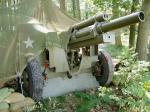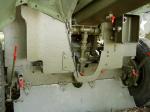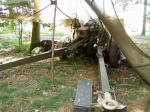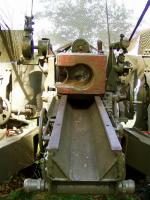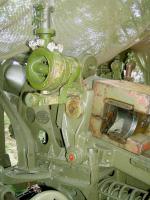
|
||||||||||||||||||||||||||||||||
Lors du premier conflit mondial de l'armée américaine ne disposa pas à son arrivée en Europe de matériels adaptés et avait dû s'approvisionner auprès de ses alliés français ou anglais. Elle acheta la licence du canon de 75 qui ne commencera seulement à être fabriqué aux USA que lorsque la guerre prit fin en Europe. La construction de cet engin continua ce qui fit que les États-Unis se retrouvèrent avec le stock important de canon de 75. Voir Aussi See Also Autres Photoscopes Others Walk Aurounds
The howitzer 105 M2a1
During WW1 the American army does not dispos on his arrival in Europe appropriate equipment and had to be supplied by its allies French or English. She bought the licence of the 75 mm gun which will start only to be manufactured in the USA when the war ended in Europe. The construction of such gunst continued what was that the United States found themselves with the large stock of 75 guns.
The immediate period following the end of WW1° saw the United States sinking into isolationism which led to the failure and rejection with the League of Nations (SDN) and more economic not favorable military equipment suffered huge budget cuts. For artillery the Westervaldt commission meets in 1919 and recommended the adoption of a 105mm campaign howitzer but his recommendation remained dead letter until 1939 In 1939 taking into account international tensions studies were times that resulted in the adoption of the howitzer M2A1 in 1940 This weapon was an immediate success and was adopted by a lot of countries around the world, some still using it. The M2A1 is a conventional weapon and little original. His carraige M2A1 is a biarroaw carriege Engineers have managed to find theperfect point of balance between carriage and barrel. This mounting confers an excellent balance at the gun. This gun has been designed from the outset for traction motor vehicle that makes it has been from the beginning with pneumatic wheels. It is quite heavy, but this gives it a cumbersome sturdy and also a high rate of fire. This gun was used by the Americans in any theatre of operations and was constantly improved. The range of projectiles is very large for the HE shells to smoke through disperseurs load. Some howitzers were mounted on armoured vehicles as M7 or track M3 Half
Why the choice of 105 mm caliber ?
In 1916 in France, an American mission led by Colonel Chaltes Summer Steel is sent to France to observe and study the development of military equipment in Europe and then guide the weapons programmes American future. The first observation was that the canon of 75 was not fully adapted to the war and the need for a barrel of a higher caliber
The US Army choice the 3 Inch Md 1916 as a standard size. During the same period in the United States some arsenals are in the process of developing howitzers of a similar calibre to 3 inch. This reinforces the engineers in their idea. When the war ends the American army has a fleet of different guns of all calibres. The Commission Westerwelt of May 23rd 1919 provides that we must begin the study of a gun with a calibre of 105mm Soon studies the development of the cannon began and in 1920 is presented the howitzer M. 1920 on carriage M1920 Four guns are built to test the concept. Each gun differs from the others by minor details. They are tested as much on the carraige on the barrel and it appears that the carraige M1920 is too complex hence it is abandonned. The studies are dragging, and in 1928 a new howitzer is introduced and adapted them as M1Hotwizer on carraige M1 But finances are lacking which causes postponement of the project. Between 1936 and 1939 various projects being set up, but nothing concrete in the meantime the 1935 howitzer M1 was adopted under the term Mr. 2 by the U.S. Army But it was not until 1939 and 1940 mainly to see this happen in armed unit Construction was started immediately and production in 1945 will reach the figure of 8538 guns It was built during the war with minor changes; It has been used by the allied armies and then by many other armed including France
Variants
Mr. 1 original standard obsolete 1928 to 1935.
Mr. 2 variant of M1 standard 1934. M2A1 variant on the system percussion with a handful of opening of the 1940 standard yoke. M4 M2A1 carriage M37 T12 projects 105 ligthen abandonment in September 1945. T51 to T88 CGM E1 abandoned in September 46.
The carriages
M 1 horse carriage.
Mr. 1A1 carriage modificated for motorized traction . M2A1 carriage with shield M.2 E4 carriage m2A1modificated to enter a Dakota. M3 streamlined carriage dropped 10% in 1945. M3A1E2 abandonment in 1146. SPG self propelled Guns T9 prototype T19 324 were built and used in North Africa. On M3 chassis T32 prototype M7. M.7 gun mounted on chassis M3.M M7B1-mounted chassis M4. M.7B2 Mounted on M4 chassis with suspension HHVS. M37 mounted on the chassis of m24.
Sheels
M1 standard standard.
M60 chemical. M84 and 84 bis smoke. HEAT M67. T18 able to deliver containers with cargo.
Specifications
Caliber 105mm.
Length 2,574 m. Weight with driving 1,934 T Scoring Azimut 46 ° Site -5 + 45 ° V ° shells 472 meters per second. Scope 12 Kgs
I wish to pay a tribute to the groups of Reconstruction Provence 1944 and the staff of the Museum of Draguignan
|
|
Droit d’auteur La plupart des photographies publiées sur ce site sont la propriété exclusive de © Claude Balmefrezol Elles peuvent être reproduites pour une utilisation personnelle, mais l’autorisation préalable de leur auteur est nécessaire pour être exploitées dans un autre cadre (site web publications etc) Les sources des autres documents et illustrations sont mentionnées quand elles sont connues. Si une de ces pièces est protégée et que sa présence dans ces pages pose problème, elle sera retirée sur simple demande. Principaux Collaborateurs:
Nb
de visiteurs:7893704 Nb
de visiteurs aujourd'hui:1032 Nb
de connectés:85 | ||||||||||||||||||||||||||||||





